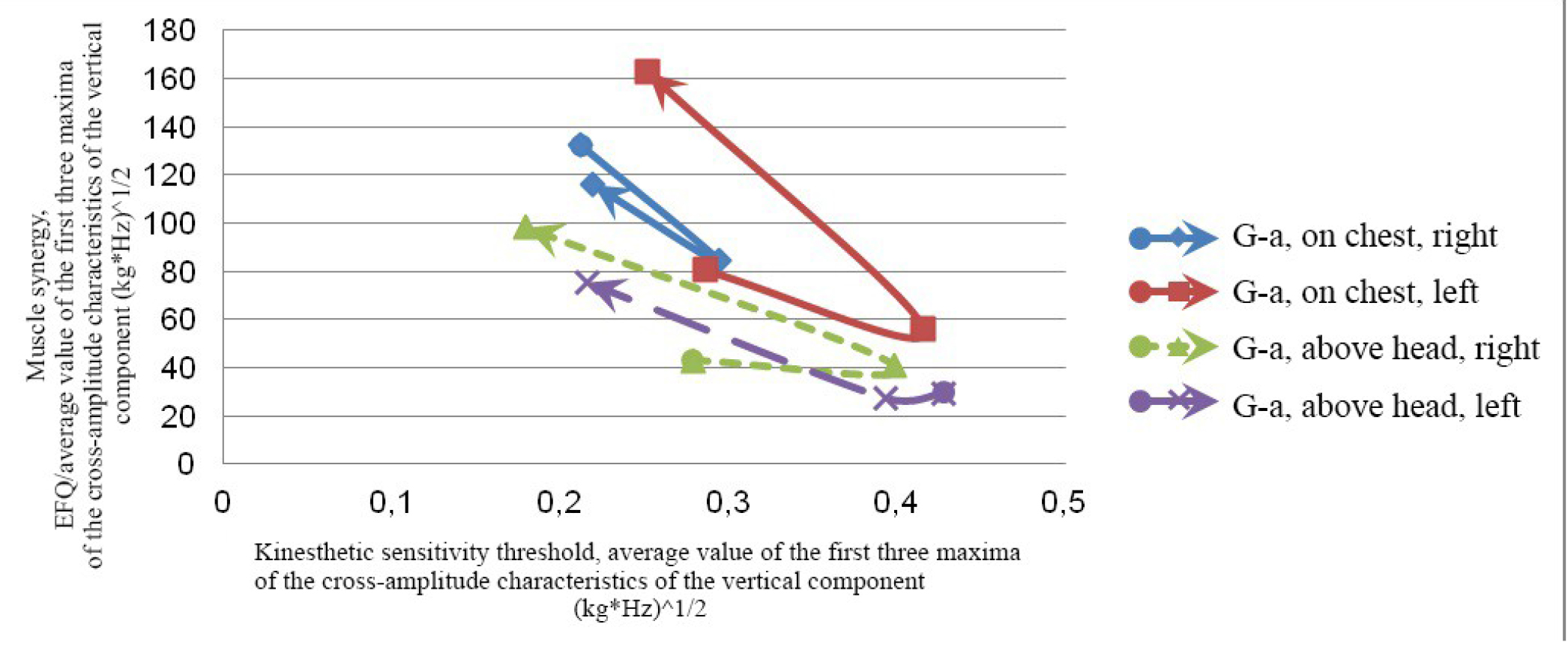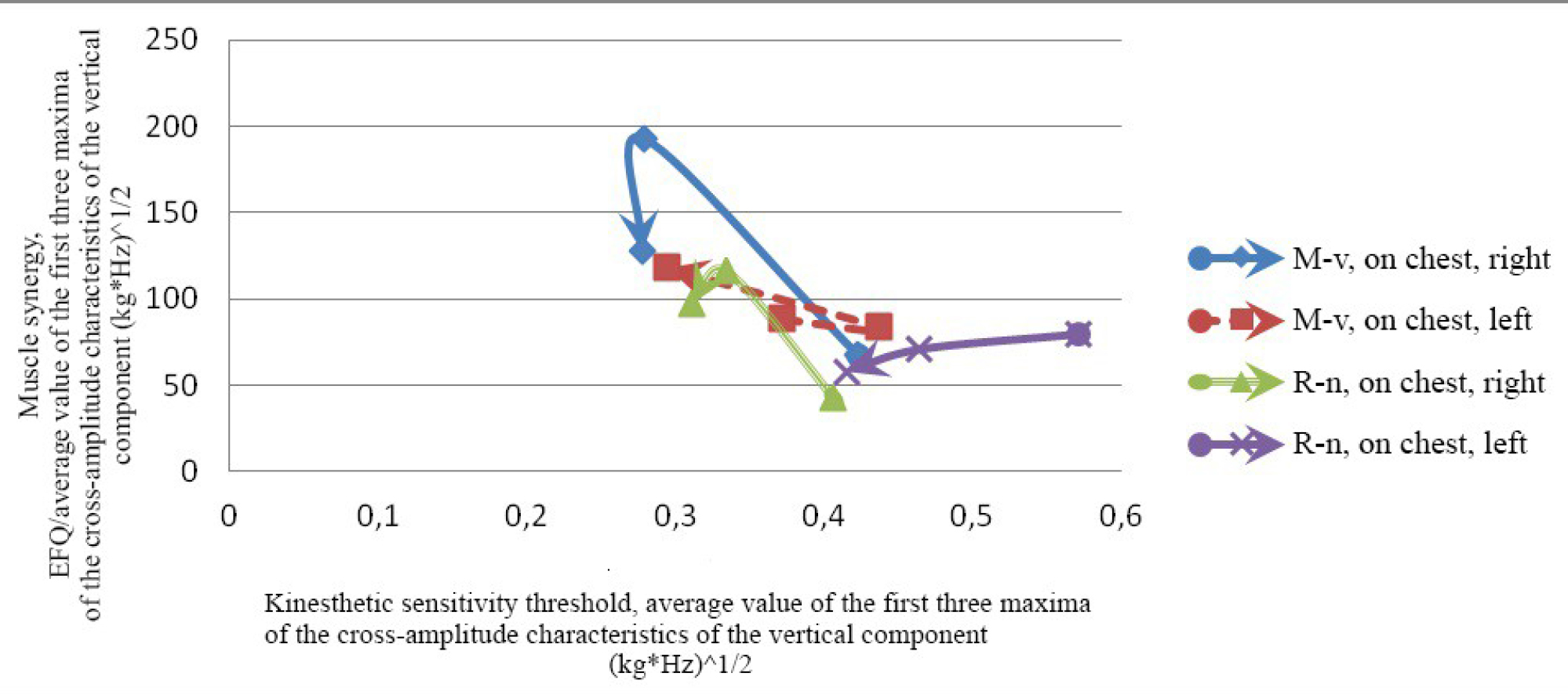Adaptive responses of neuromuscular system to training loads in youth kettlebell lifting sport
Фотографии:
ˑ:
PhD, Associate Professor R.M. Gimazov1
PhD, Associate Professor G.A. Bulatova1
1Surgut State Pedagogical University, Surgut
Keywords: physical load, kinesthetic sensitivity, muscle synergy, athletes, stabilometrics.
Introduction. According to the Federal State Educational Standards of the Russian Federation, sportization of physical education in a comprehensive school is meant primarily to preserve schoolchildren’s health and their harmonious physical development. Kettlebell lifting sport imposes heightened requirements to the control of physical loads junior athletes are exposed to, since the body is affected by a small amount of movements performed in a standing position, but with heavy weights in total.
Objective of the study was to analyse the adaptive responses of the neuromuscular system to training loads in schoolchildren engaged in kettlebell lifting sport.
Methods and structure of the study. For the purposes of the study we applied a stabilometric version of the Romberg’s eyes-open test in the “American stance” to profile the pressure centre fluctuation biomechanics, with the subject alternatively holding the kettlebell in front of the chest and above the head with the right and left hands for 12 seconds. The essence of this methodology is in detecting the current adaptive responses of the neuromuscular system of the athlete while maintaining the stance based on the following indicators: kinesthetic sensitivity, muscle synergy (Invention patent RU 2547991) [1, p. 21]. The study was performed in October and December 2016 and March 2017 in the Physical Education and Ethnic Pedagogical Research Laboratory of Surgut State Pedagogical University. Subject to the study were 3 trainees of the sport and fitness complex “Gazovik”, Surgut (trainer - J.A. Kutcherenko).
Results and discussion. All three junior kettlebell lifters were observed to have improved their physical and technical fitness indices during the experiment. The study using modern diagnostic tools and techniques to detect the responses of the neuromuscular system of schoolchildren to physical loads [3, p.123], stabilometrics in particular, demonstrates controversial positive changes in the physical and technical fitness indices of the schoolchildren.

Figure 1. Results demonstrated by female athlete G-a in alternated holding of 8-kg kettlebell in front of chest and above head in right and left hands for 12 seconds
As seen from Figure 1, at the beginning of the experiment (October), the 15-year-old female athlete G-a demonstrated an average result in holding of the kettlebell in the left hand, in the middle of the experiment (December) her result was poor, and at the end (March) it was closer to the above average level [2, p.28; 4, p.42]. In holding of the kettlebell in front of the chest in the right hand, the hold dynamics ranged from the average to below average, and then to the average level of muscular regulation of motor activity. In general, the dynamics of changes in the kinesthetic sensitivity values when holding the kettlebell above the head testifies to the dynamics of holding the kettlebell in front of the chest. Given that the December measurements were made after the past cold-related diseases, and the March measurements showed that the kinesthetic sensitivity values increased and almost reached the above average level, and taking into account the detected physical and technical progress of the given athlete, it is fair to say that training of the junior female kettlebell lifter G-a does not lead to a breakdown of the adaptive responses of her neuromuscular system to training loads and, judging by the positive dynamics in the level of muscular regulation, further increase in the level of her technical fitness is expected.
A different picture of adaptive responses of the body is observed in junior male athletes M-v and R-n (Figure 2).

Figure 2. Results demonstrated by male athletes М-v and R-n in alternative holding of 16-kg kettlebell in front of chest in right and left hands for 12 seconds
During the stabilometric test of muscle synergy when holding the 16-kg kettlebell in front of the chest in the right hand, 16-year-old male athlete M-v demonstrated higher results in the middle of the experiment and a sharp decrease of values to the low level at the end of the educational experiment. The kinesthetic sensitivity values when holding the kettlebell in front of the chest in the left hand initially indicated a low level (not the dominant arm), and decreased even more in the middle of the experiment. By the end of the experiment, the values increased and reached those of the right hand. In male athlete R-n the “cost” of alternated holding of the kettlebell in front of the chest (based on the kinesthetic sensitivity values) in the right and left hands decreased gradually by the end of the experiment, but at the same time the muscle synergy values decreased. It should be noted that the athlete who held the kettlebell in front of the chest in the right hand in the middle of the experiment, in contrast to left-hand hold, demonstrated an increase in the muscle synergy values in the middle of the experiment.

Figure 3. Results demonstrated by athletes М-v and R-n in alternated holding of 16-kg kettlebell above head in right and left hands for 12 seconds
The “cost” of holding the kettlebell above the head (based on the kinesthetic sensitivity values) is different for the right and left hands in both male athletes. In athlete М-v the right-hand hold values increase, and those of the left hand – decrease by the end of experiment. In athlete R-n, on the contrary, the kinesthetic sensitivity values when holding the kettlebell above the head in the right hand decrease, and those of the left hand – slightly increase. Muscle synergy improves in both male athletes. Since the stabilometric test showed a decrease in the level of muscular regulation of athletic movements in junior athletes M-v and R-n, it should be assumed that their technical and physical progress was due to the excess of the adaptive capabilities of the athletes’ neuromuscular system [5, p.14].
The focus of trainers on psychophysical training (development of patience, readiness to keep working under fatigue, etc.) of kettlebell lifters should not be limited to physical and technical progress of junior athletes. Insufficiency of the neuromuscular system in the process of movement formation leads to permanent motor errors, inner dissatisfaction of the athletes with the kettlebell lifting sport. Such a situation may finally lead to the less efficient athletic movements excelling process, and the schoolchildren can quit kettlebell lifting. The author's method applied for monitoring and evaluating the kinesthetic sensitivity and muscle synergy significantly expands the possibilities of stabilometrics. Our findings are at variance with the conclusions of foreign scientists on the impossibility to detect any differences in the postural stability of junior athletes by means of stabilometrics [6].
Conclusion: The evaluation of the schoolchildren’s neuromuscular system responses to physical loads using stabilometrics revealed the contradictory positive changes in the physical and technical training of kettlebell lifters. It should be noted that despite the initial technical and physical progress of junior athletes the negative disadaptation phenomena may be found in the neuromuscular system affecting the efficiency of the athletic movements excelling process.
The study was conducted as part of the government scientific task Scientific Research 08/2016-2018 “Research and methodological support of FSES of sports training in educational establishments”.
References
- Gimazov R.M., Starykh Yu.Yu., Loginov S.I. Vzaimosvyaz stabilometricheskikh pokazateley posturalnoy myshechnoy koordinatsii i pokazateley elektroneyromiografii nervov nizhney konechnosti sportsmenov [Correlation of stabilometric postural muscular coordination indicators with lower limb nerve electroneuromyographic indicators of athletes]. Teoriya i praktika fiz. kultury, 2016, no. 8, pp. 20-23.
- Gimazov R.M., Bulatova G.A. Klassifikatsiya pokazateley kinesteticheskoy chuvstvitelnosti i soglasovannykh myshechnykh napryazheniy u sportsmenov pri regulyatsii vertikalnoy stoyki s otkrytymi glazami [Classification of indices of kinesthetic sensitivity and coordinated muscular strains in athletes at eyes-open vertical stance control]. Mater. II Vseros. nauch.-prakt. konf. s mezhdunar. uchastiem "Biomekhanika sportivnykh dvigatelnykh deystviy i biomekhanicheskiy kontrol v sport" [Proc. II Vseros. res.-pract. conf. with intern. participation "Biomechanics of sporting motor actions and biomechanical control in sports"]. Moscow State Academy of Physical Culture publ., Malakhovka, 2014, pp. 24-29.
- Gimazov R.M., Bulatova G.A. Normirovanie fizicheskikh nagruzok v trenirovochnom protsesse na osnove ucheta myshechnoy reaktivnosti [Grading physical loads in training process in view of muscular reactivity]. Mater. Vseros. nauch.-prakt. internet-konf. "Aktualnye problemy biokhimii i bioenergetiki sporta XXI veka" [Proc. All-Rus. res.-pract. Internet-conference. "Actual problems of biochemistry and bioenergetics of sports of XXI century"]. April, 25-26, 2016. Ed. R.V. Tambovtseva, V.N. Cheremisinov, S.N. Litvinenko, I.A. Nikulina, O.S. Zhumaev, E.V. Pletneva. Moscow: RSUPCSYT (GTSOLIFK) publ., 2016, pp. 119-124.
- Gimazov R.M., Bulatova G.A. Otsenka reaktsiy nervno-myshechnoy sistemy sportsmena na fizicheskie nagruzki [Assessment of reactions of athlete's neuromuscular system to physical activity]. Uchenye zapiski un-ta im. P.F. Lesgafta, 2013, no. 11 (105), pp. 39-44.
- Gimazov R.M., Bulatova G.A. Stabilometriya v diagnostike adaptatsii dvigatelnogo apparata sportsmena [Stabilometry in diagnostics of adaptation of athlete's motor system]. Mater. Vseros. nauch.-prakt. konf. "Biomekhanika sportivnykh dvigatelnykh deystviy i sovremennye instrumentalnye metody ikh kontrolya" [Proc. All-Rus. res.-pract. conf. "Biomechanics of sporting motor actions and modern instrumental control methods"]. Moscow State Academy of Physical Culture publ., Malakhovka, 2013, pp.12-16.
- Russo L., D'Eramo U., Padulo J., Foti C., Schiffer R., Scoppa F. Day-time effect on postural stability in young sportsmen. Muscles Ligaments Tendons J. 2015. Mar 27;5(1):38-42.
Corresponding author: rmgi@mail.ru
Abstract
The modern youth kettlebell lifting sport is particularly sensitive to the physical workload design and management by the trainers. The article reports a few cases of regress in the individual muscular synergy and kinaesthetic sensitivity in junior athletes due to the individual adaptive mechanisms being overstressed by the mismanaged training. For the purposes of the study we applied a stabilometric version of the Romber’s eyes-open test in the “American stance” to profile the pressure centre fluctuation biomechanics, with the subject alternatively holding the kettlebell in front of the chest and above the head in the right and left hands for 12 seconds. The study was performed in October and December 2016 and March 2017 in the Physical Education and Ethnic Pedagogical Research Laboratory of Surgut State Pedagogical University, with 3 athletes being subject to the study.
The study data and analyses showed that the modern diagnostic methods and tools designed to rate the neuromuscular system responses to physical loads often yield quite contradictory physical and technical progress data when junior athletes are tested. We believe that some initial physical and technical progress demonstrated by junior athletes may be associated with concealed disadaptational effects in the neuromuscular system that later may seriously hamper progress of the athletes and their competitive accomplishments.




